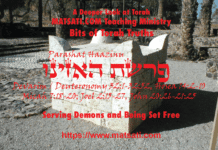In weeks reading from Parashat Metzora (Vayikra / Leviticus 14:1-15:33), we learn about the mitzvot (Commandments) on the law of Tzaraat (צָּרַעַת, leprosy). The translation for the word Leprosy comes from the Greek word “Lepra” (λέπρα) and is a contagious bacterial disease characterized by ulceration’s of the skin, a loss of sensation (nerve damage) and sever deformities. The regulation connected to the commandment is found in Vayikra / Leviticus 13 and 14, and Bamidbar / Numbers 12. In the Scriptures, this disease was regarded as a direct infliction by God (see 2 Kings 5:7 and 2 Chronicles 26:20) an awful punishment from the Lord. The disease eats the inward parts, the bones, swelling of the skin, sores, the whole body is rotting and in Yeshua’s day this was considered a slow lingering death sentence. The one stricken with Tzaraat was to rent his own cloths in lamentation of his own approaching death and cry out “Tamei! Tamei!” (“Unclean! Unclean!”) when passers-by came near to keep them away. According to the Torah it appears that it is the Lord God who inflicts one with Tzaraat and it is only Lord God who is able to heal the leper.
ספר ויקרא פרק יד
א וַיְדַבֵּר יְהוָֹה אֶל-מֹשֶׁה לֵּאמֹר: ב זֹאת תִּהְיֶה תּוֹרַת הַמְּצֹרָע בְּיוֹם טָהֳרָתוֹ וְהוּבָא אֶל-הַכֹּהֵן: ג וְיָצָא הַכֹּהֵן אֶל-מִחוּץ לַמַּחֲנֶה וְרָאָה הַכֹּהֵן וְהִנֵּה נִרְפָּא נֶגַע-הַצָּרַעַת מִן-הַצָּרוּעַ:
Vayikra / Leviticus 14:1-3
14:1 Then the Lord spoke to Moses, saying, 14:2 ‘This shall be the law of the leper in the day of his cleansing. Now he shall be brought to the priest, 14:3 and the priest shall go out to the outside of the camp. Thus the priest shall look, and if the infection of leprosy has been healed in the leper… (NASB)
While studying Parashat Metzora, it is always interesting to look at Midrash Rabbah to see what the rabbis have to say. Midrash Rabbah Vayikra on Parashat Metzora (Chapter 16-18, פרשה טז-יח) speaks extensively on Tzaraat and Lashon Harah, the evil tongue (gossip). The idea is that there is an inward uncleanness that is so great, that God causes it to show forth on the outside as Tzaraat. According to Parashat Tazria and Metzora, there is no sacrifice that could be brought that was capable of making the one afflicted with Tzaraat clean before the Lord. The sin in this persons life was so great, the one inflicted of this disease must wholly trust in the Lord God Almighty for the forgiveness of their sins and healing. The sacrifices that one brings may only be done so after having been healed from the disease of Tzaraat. Right standing and renewed fellowship with the Lord could only occur after the Lord had forgiven and healed this person. This in and of itself presents a key Torah principle that the Lord desires mercy and obedience rather than sacrifice (1 Samuel 15:22). The one stricken with Tzaraat needs to be both forgiven for his sins and healed of the disease by the Lord God Almighty. The disease of Tzaraat illustrates for us that the sacrifices were not meant to be performed to “earn” forgiveness of sins. Many Christian commentaries suggest the sacrifices were meant to take away sin which is a work of the flesh (see Gill’s Exposition on Isaiah 55:7 for an example). Studying the Torah on the sacrifices, reveals to us that a sacrifice was to be brought if we discover that we had unintentionally sinned before God. If one had “intentionally” sinned before God, there was no sacrifice that could be brought. The person who “intentionally” sins needed to repent and trust the our Father in Heaven would forgive him. With these things in mind, the rabbis of blessed memory struggled with the idea of how God forgives those stricken with Tzaraat and conclude this would be the work of the Messiah.
Talmud Bavli, Sanhedrin daf 98b
“Rab said: The world was created only on David’s account . Samuel said: On Moses account; R. Johanan said: For the sake of the Messiah. What is his [the Messiah’s] name? — The School of R. Shila said: His name is Shiloh, for it is written, until Shiloh come. The School of R. Yannai said: His name is Yinnon, for it is written, His name shall endure for ever: e’er the sun was, his name is Yinnon. The School of R. Haninah maintained: His name is Haninah, as it is written, Where I will not give you Haninah. Others say: His name is Menahem the son of Hezekiah, for it is written, Because Menahem [‘the comforter’], that would relieve my soul, is far. The Rabbis said: His name is ‘the leper scholar,’ as it is written, Surely he hath borne our griefs, and carried our sorrows: yet we did esteem him a leper, smitten of God, and afflicted.”
Since the disease of Tzaraat was something only the Lord God Almighty could heal, the rabbis say the Annointed One (Mashiach) would need to help those stricken with Tzaraat. The Talmud describes the rabbi’s asking the question, “when will the Messiah come?” and “By what sign may I recognize him?” Elijah tells the rabbi to go to the gate of the city where he will find the Messiah sitting among the poor lepers. According to the Sages, the Messiah would be a Cohen (Priest) that would bear our grief, carry our iniquity and sorrows, and be smitten of God and afflicted. There seem to be parallels to Parashat Ki Tisa (Shemot / Exodus 30:11-34:35) and Isaiah 53 with regard to Moshe and the man smitten and afflicted. It is possible that the Chief priests and elders in Yeshua’s day knew of these sayings in the first century. It is also apparent that the lawyers and leaders in Yeshua’s day were unwilling to recognize the various messianic prophecies in the Tanakh and refused to recognize the declaration of who Yeshua is in the healing of these persons stricken with Tzaraat. In the Apostolic Writings, when Yeshua healed ten lepers, he was declaring in the act of healing that God was present a clear sign that the one spoken of in the Torah as the prophet that would follow Moshe (Devarim / Deuteronomy 18) had come “The Messiah has come!” Remember, Moshe prayed to the Lord and the Lord listened and healed Miriam (Bamidbar / Numbers 12). Yeshua healing lepers is found in Matthew 8:2-3, Mark 1:40-42, and Luke 17:11-19. In Luke 17:11-19, while Yeshua was on his way to Jerusalem and passing between Samaria and Galilee he met 10 lepers. The Lepers raised their voices saying 17:13 “… ‘Jesus, Master, have mercy on us!’” Yeshua told the lepers to go and show themselves to the Cohanim (Priests) and as they went they were healed, cleansed of the disease as they made their way to show themselves to the Cohen. As these 10 Lepers acted in faith, the Lord God healed them of their disease of Tzaraat. Based upon the text it appears the men (i) believed Yeshua was able to heal them and (ii) they needed to act upon their faith even though the Tzaraat remained upon their bodies physically. The work of believing and then physically doing what the Lord instructs us to do are integrally connected. By performing the act of going to the Cohen to show their bodies they were healed. Now because they were obeying Yeshua to show themselves to the priests, as the Torah commands, they were doing a righteous work. Did their healing come by their own hands (by their works), or by the power of God? Their moving by faith to show their bodies, even though there remained the sign of Tzaraat, glorified the name of the Lord and God healed them.
According to Parashat Metzora, the ritual cleansing process required the rigorous procedure of inspection and blood atonement as described in the Torah. Note again that these sacrifices come after having been forgiven of their sin and having been healed. According to the Scriptures in Vayikra / Leviticus 14:2-3 ב זֹאת תִּהְיֶה תּוֹרַת הַמְּצֹרָע בְּיוֹם טָהֳרָתוֹ וְהוּבָא אֶל-הַכֹּהֵן: ג וְיָצָא הַכֹּהֵן אֶל-מִחוּץ לַמַּחֲנֶה וְרָאָה הַכֹּהֵן וְהִנֵּה נִרְפָּא נֶגַע-הַצָּרַעַת מִן-הַצָּרוּעַ: ד וְצִוָּה הַכֹּהֵן וְלָקַח לַמִּטַּהֵר שְׁתֵּי-צִפֳּרִים חַיּוֹת טְהֹרוֹת וְעֵץ אֶרֶז וּשְׁנִי תוֹלַעַת וְאֵזֹב: 14:2 ‘This shall be the law of the leper in the day of his cleansing. Now he shall be brought to the priest, 14:3 and the priest shall go out to the outside of the camp. Thus the priest shall look, and if the infection of leprosy has been healed in the leper (NASB). The person with Tzaraat is to meet the Cohen (Priest) half way. Yeshua sent the lepers to show their bodies to the Cohen because the first step of acting in faith is crucial for a believer. It is only when we sincerely return to the Lord and act upon our faith that He will take care of our problem of impurity, uncleanness, and sin. According to the Scriptures only the Cohen could diagnose Tzaraat. The reason being, Tzaraat was a spiritual malady that required spiritual discernment to both diagnose and treat. When someone was found to have Tzaraat, they were forced to leave society and undergo a period of mourning and Teshuvah (repentance). Before the leper is reintegrated into the community of believers, he must undergo inspection and kept aside for seven days and then reexamined, and only then is the person allowed to return to the community.
According to the Apostolic writings, Yeshua healed 10 lepers, he showed himself to be the Messiah, having both the power to forgive sins and to set one free from the bondage of sin and death (the slow lingering death of Tzaraat). Because of Yeshua we are no longer lepers or outcasts from the family of God. He has brought us into right standing before our Father in Heaven. During Yeshua’s ministry he pointed continually to the Torah instructing those healed of Tzaraat to show themselves to the Cohen and make the necessary offerings described in the Torah as a testimony to Moshe and to the people. In this week’s study the Lord reveals to us the uncleanness and impurity in our lives on the inside is also apparent to God on the outside. The internal state effects our walk before the Lord. Have you inspected your life, the uncleanliness of your heart, and sought forgiveness in the Messiah Yeshua to cleans from all unrighteousness? BTT_Parashat Metzora-2014








